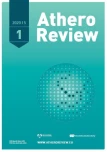Comments on the new recommendations for dyslipidemia and cardiovascular risk management with regard to diabetes mellitus
Authors:
Branislav Vohnout 1-4; Rid Bugáňová 5
Authors‘ workplace:
Ústav výživy, FOaZOŠ SZU v Bratislave
1; Koordinačné centrum pre familiárne hyperlipoproteinémie, SZU v Bratislave
2; Ústav epidemiológie LF UK v Bratislave
3; Diabeda s. r. o., Bratislava
4; MEDIVASA s. r. o., Žilina
5
Published in:
AtheroRev 2020; 5(1): 16-20
Category:
Guidelines
Overview
Two important guidelines for prevention of cardiovascular disease in diabetes and prediabetes and for the management of dyslipidaemias were published in 2019 (ESC/EASD 2019, ESC/EAS 2019). Both present new information on risk stratification and treatment of dyslipidemias in patients with diabetes. According the new recommendations diabetics are a priori at very-high, high or moderate cardiovascular risk based on presence of target organ damage, other major risk factors, age and duration of diabetes. The most important change in the guidelines is significant shift towards lower LDL-C treatment goals and a minimum 50 % reduction, together with reaching the tailored goal for very-high (< 1.4 mmol/l) and high (< 1.8 mmol/l) risk categories and a new goal (< 2.6 mmol/l) for moderate risk.
Keywords:
diabetes – dyslipidemia – LDL-C – recommendation – risk
Sources
- Sarwar N, Gao P, Seshasai SR et al. [Emerging Risk Factors Collaboration]. Diabetes mellitus, fasting blood glucose concentration, and risk of vascular disease: a collaborative meta-analysis of 102 prospective studies. Lancet 2010; 375(9733): 2215–2222. Dostupné z DOI: <http://dx.doi.org/10.1016/S0140–6736(10)60484–9.>. Erratum in Lancet 2010; 376(9745): 958. Hillage, H L [corrected to Hillege, H L].
- Cosentino F, Grant PJ, Aboyans V et al. 2019 ESC Guidelines on diabetes, pre-diabetes, and cardiovascular diseases developed in collaboration with the EASD. Eur Heart J 2020; 41(2): 255–323. Dostupné z DOI: <http://dx.doi.org/10.1093/eurheartj/ehz486>.
- Ritsinger V, Hero C, Svensson AM et al. Characteristics and prognosis in women and men with type 1 diabetes undergoing coronary angiography: a nationwide registry report. Diabetes Care 2018; 41(4): 876–883. Dostupné z DOI: <http://dx.doi.org/10.2337/dc17–2352>.
- [Prospective Studies Collaboration and Asia Pacific Cohort Studies Collaboration]. Sex-specific relevance of diabetes to occlusive vascular and other mortality: a collaborative meta-analysis of individual data from 980 793 adults from 68 prospective studies. Lancet Diabetes Endocrinol 2018; 6(7): 538–546. Dostupné z DOI: <http://dx.doi.org/10.1016/S2213–8587(18)30079–2>.
- Olesen KKW, Madsen M, Egholm G et al. Patients with diabetes without significant angiographic coronary artery disease have the same risk of myocardial infarction as patients without diabetes in a real-world population receiving appropriate prophylactic treatment. Diabetes Care 2017; 40(8): 1103–1110. Dostupné z DOI: <http://dx.doi.org/10.2337/dc16–2388>.
- Rawshani A, Rawshani A, Franzén S et al. Mortality and cardiovascular disease in type 1 and type 2 diabetes. N Engl J Med 2017; 376(15): 1407–1418. Dostupné z DOI: <http://dx.doi.org/10.1056/NEJMoa1608664>.
- Mach F, Baigent C, Catapano AL et al. 2019 ESC/EAS Guidelines for the management of dyslipidaemias: lipid modification to reduce cardiovascular risk. Atherosclerosis. 2019; 290: 140–205. Dostupné z DOI: <http://dx.doi.org/10.1016/j.atherosclerosis.2019.08.014>. Erratum in Erratum to “2019 ESC/EAS guidelines for the management of dyslipidemias: Lipid modification to reduce cardiovascular risk” [Atherosclerosis 290 (2019) 140–205]. [Atherosclerosis. 2020]. Corrigendum to “2019 ESC/EAS Guidelines for the management of dyslipidaemias: lipid modification to reduce cardiovascular risk” [Atherosclerosis 290 (2019) 140–205]. [Atherosclerosis. 2019].
- Piepoli MF, Hoes AW, Agewall S et al. [Authors/Task Force Members]. 2016 European Guidelines on cardiovascular disease prevention in clinical practice: The Sixth Joint Task Force of the European Society of Cardiology and Other Societies on Cardiovascular Disease Prevention in Clinical Practice (constituted by representatives of 10 societies and by invited experts) Developed with the special contribution of the European Association for Cardiovascular Prevention & Rehabilitation (EACPR). Atherosclerosis 2016; 252: 207–274. Dostupné z DOI: <http://dx.doi.org/10.1016/j.atherosclerosis.2016.05.037>.
- Dostupné z WWW: <http://www.euro.who.int/en/health-topics/noncommunicable-diseases/obesity/data-and-statistics>. [04–01–2020]
- Sillars A, Sattar N. Management of Lipid Abnormalities in Patients with Diabetes. Curr Cardiol Rep 2019; 21(11): 147. Dostupné z DOI: <http://dx.doi.org/10.1007/s11886–019–1246–1>.
- Giugliano RP, Cannon CP, Blazing MA et al. Benefit of adding ezetimibe to statin therapy on cardiovascular outcomes and safety in patients with versus without diabetes mellitus. Circulation 2018; 137:1571–1582. Dostupné z DOI: <http://dx.doi.org/10.1161/CIRCULATIONAHA.117.030950>.
Labels
Angiology Diabetology Internal medicine Cardiology General practitioner for adultsArticle was published in
Athero Review

2020 Issue 1
- Memantine Eases Daily Life for Patients and Caregivers
- Memantine in Dementia Therapy – Current Findings and Possible Future Applications
- What Effect Can Be Expected from Limosilactobacillus reuteri in Mucositis and Peri-Implantitis?
- Metamizole at a Glance and in Practice – Effective Non-Opioid Analgesic for All Ages
- Advances in the Treatment of Myasthenia Gravis on the Horizon
Most read in this issue
- Uric acid and influence of hyperuricaemia therapy on prevention of atheroscleroris and cardiovascular diseases
- Comments on the new recommendations for dyslipidemia and cardiovascular risk management with regard to diabetes mellitus
- Homocysteine consensus
- Insulin resistance and atherosclerosis: implications for insulin-sensitizing agents
